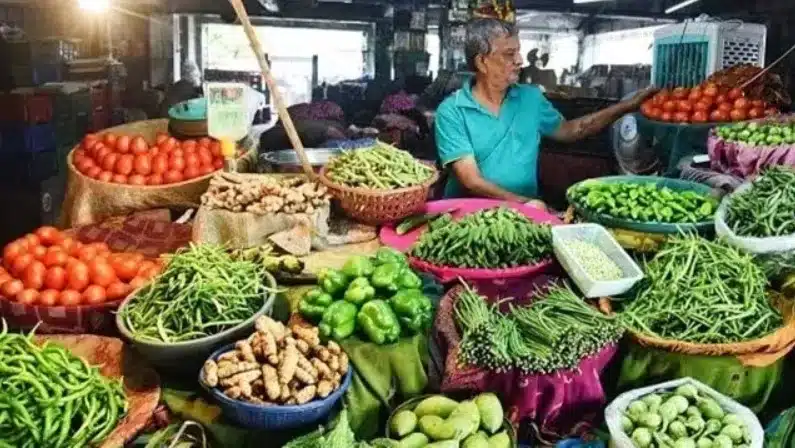What’s in today’s article?
- Why in news?
- Key takeaways from the 2022-23 survey
Why in news?
- Recently, the Ministry of Statistics and Programme Implementation, released data on household consumption expenditure for the year 2022-23.
- The data shows per capita monthly household expenditure more than doubled in 2022-23 as compared to 2011-12.
Key takeaways from the 2022-23 survey
- Share of spending on food in India changed over the last 20-odd years
- Between 1999-2000 and 2022-23, the share of expenditure on food has gradually declined for both urban and rural households.
- However, it is for the first time that expenditure on food has fallen to less than 50 per cent of the total consumption expenditure in rural India, and to less than 40 per cent in urban India.
- Within foods, what are we eating?
- The share of cereals and pulses within overall food consumption expenditure has reduced, both in rural and urban areas.
- The share of spending on milk has increased, so much so as to overtake that on cereals and pulses combined — i.e. foodgrains — in 2022-23.
- The average rural as well as urban Indian has, for the first time in 2022-23, spent more on fruits and vegetables than on foodgrains.
- The spending on vegetables alone exceeded that on cereals, and likewise for fruits vis-a-vis pulses.
- A growing share of the consumer rupee is also going to eggs, fish and meat.
- When combined with the rising and falling shares of milk and pulses respectively, it suggests a clear preference among Indian consumers for animal proteins over plant proteins.
- Indians are spending more, as a percentage of their total expenditure, on processed foods, beverages and purchased cooked meals.
- Spending on food and the items consumed supports Engel Curve hypothesis
- Named after the 19th century German statistician Ernst Engel, it broadly states that as incomes grow, households spend a smaller proportion of that on food.
- Even within food, they would buy more of “superior” and less of “inferior” items.
- In the present case, cereals, sugar and pulses are inferior, while milk, egg, fish, meat, fruits and vegetables, beverages and processed foods are superior.
- Narrowing rural-urban gap
- The data shows consumption in rural areas is growing faster than in urban areas, thereby narrowing the gap.
- If the trend continues, it is possible that urban and rural incomes and consumption will be the same in the coming years.
- The average monthly per capita consumption expenditure (MPCE) of agricultural households
- For the first time, MPCE of agricultural households has fallen below the overall average of rural households.
- The average MPCE of families self-employed in agriculture was Rs 3,702 in 2022-23, while the overall average of rural households was Rs 3,773.
- The gap between the MPCE of agricultural families and the overall average of rural households has been narrowing over the years.
- The MPCE of casual labourers and regular wage earners engaged in agriculture was also lower than the rural average
- Need to review the inflation basket
- Inflation is calculated based on the changes in the price levels of items in a large basket. These items must ideally reflect what Indians are consuming.
- The Consumer Price Index (CPI)-based inflation, also called retail inflation, is currently based on a basket that was decided in 2012.
- However, over the last 11 years, as the latest Household Consumption Expenditure (HCE) Survey 2022-23 shows, a lot has changed.
- For example, the CPI (Rural) basket assigns a weightage of 12.35 per cent to ‘cereals and products’.
- But as discussed above, the latest HCE Survey shows rural households spend just 4.91 per cent on cereals (and cereal substitutes).
- On poverty
- As per NITI Aayog CEO B V R Subrahmanyam, the latest consumer expenditure survey indicates that poverty has come down to five per cent in the country.
- People are becoming prosperous both in rural and urban areas.
- The data showed that the average per capita monthly expenditure for all categories stood at Rs 3,773 in rural areas and Rs 6,459 in urban areas.
- The average per capita monthly expenditure of 0-5% fractile (bottom 5%) class is pegged at Rs 1,373 in rural areas and Rs 2,001 in urban areas.
- As per NITI Aayog CEO B V R Subrahmanyam, the latest consumer expenditure survey indicates that poverty has come down to five per cent in the country.
- Demand for a legal guarantee to MSP and the survey data
- The demand for a legal guarantee to MSP is mainly from farmers of 23 crops, including foodgrains and sugarcane.
- But farm sector’s growth is being led by livestock, fisheries and horticulture crops outside MSP purview.
- However, the survey data shows that their growth is largely market demand-driven.
- Hence, it raises an important question:
- if consumption of milk, fish, poultry products, and fruits and vegetables is rising much more than cereals and sugar, shouldn’t the focus be on promoting production of the former as opposed to the latter?
Q1) Where is National Statistical Office (NSO)?
The National Statistical Office (NSO) is a wing of the Ministry of Statistics and Program Implementation (MoSPI). The NSO’s primary function is to collect, compile, and release official statistics.
Q2) What is Engel curve hypothesis?
The Engel curve hypothesis, also known as Engel’s Law, describes the relationship between a household’s income and its expenditure on goods and services.
Source: Household Consumption Expenditure Survey: Indians spending more on milk, fruits and vegetables than foodgrains | Indian Express
Last updated on January, 2026
→ Check out the latest UPSC Syllabus 2026 here.
→ Join Vajiram & Ravi’s Interview Guidance Programme for expert help to crack your final UPSC stage.
→ UPSC Mains Result 2025 is now out.
→ UPSC Notification 2026 is scheduled to be released on January 14, 2026.
→ UPSC Calendar 2026 has been released.
→ UPSC Prelims 2026 will be conducted on 24th May, 2026 & UPSC Mains 2026 will be conducted on 21st August 2026.
→ The UPSC Selection Process is of 3 stages-Prelims, Mains and Interview.
→ Prepare effectively with Vajiram & Ravi’s UPSC Prelims Test Series 2026 featuring full-length mock tests, detailed solutions, and performance analysis.
→ Enroll in Vajiram & Ravi’s UPSC Mains Test Series 2026 for structured answer writing practice, expert evaluation, and exam-oriented feedback.
→ Join Vajiram & Ravi’s Best UPSC Mentorship Program for personalized guidance, strategy planning, and one-to-one support from experienced mentors.
→ UPSC Result 2024 is released with latest UPSC Marksheet 2024. Check Now!
→ UPSC Toppers List 2024 is released now. Shakti Dubey is UPSC AIR 1 2024 Topper.
→ Also check Best UPSC Coaching in India

















